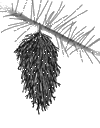Unwanted Visitors
They'll Kill Your Trees & Shrubs.
Every year, bagworms (Thyridopteryx ephemeraeformis) infest millions and kill thousands of trees in York County. Many people don't know what these things are. Most people think they're cones that naturally form on conifers (coniferous trees) and when the tree begins dying, it was just a bad tree or that they did something wrong. Not so. The reality is that bagworms are the larvae of moths. The tell-tale 2-3" brown bags are seen attached to the ends of twigs and branches, and are composed of interwoven bits of dead foliage, twigs and silk. Each summer, a dark brown or black caterpillar can be found in the bag. It drags the bag behind it as it feeds on new leaves, enlarging the bag. By August, the caterpillar finishes feeding and attaches the bag to a twig. Inside the bag, it forms a pupa (a transitional state between juvenile and adult stages). Several days later, an adult moth emerges from the pupa casing. The female is wingless and stays within the bag. The male - which lives as a worm in the ground until it hatches and turns into a moth - flies to the bag containing the female and they mate while she is still inside. She then lays a mass of eggs within the bag and dies. The eggs hatch in early May. The new caterpillars crawl from the bag and begin voraciously feeding on the plant's leaves. In severe infestations, the entire plant or tree is defoliated and dies. Without needles, an evergreen (spruce, pines, arbs etc) plant can't make chlorophyll to feed itself and starves to death. A deciduous (viburnum, forsythia etc) shrub simply goes dormant, yet can push out another, smaller set of leaves and will probably survive the infestation. The destruction can be quick and complete on an evergreen; almost overnight. Bagworms are known to frequent large shade trees: beeches, zelkova, maples, oaks, locusts and more. They are even known to take up housekeeping on inanimate objects, such as split rail fences, aluminum siding and even automobiles. Yep.
What to do? Call us. Time is of the essence: the longer you wait - thinking the bagworms are harmless
Why do we tell you this about bagworms? Simple: no one else does. We'd like to see the plants you do have now flourish. And we'd also like to sell you some of our rare, unusual and hard-to-find plant material for your gardens. But we'd like you to know what dangerous critters are out there waiting to damage your precious plants: bagworms are just one of many to be on the lookout for. 1997 was a bad year for bagworms. 1998 is shaping up to be even worse. Yes Virginia, there is again truth in advertising. Always has been in ours. In addition to telling gardeners about evils such as bagworms, we feature over 900 varieties of perennials, 200 varieties of annuals and herbs, over 100 varieties of ornamental grasses and bamboos, and more than 1600 cultivars of nursery stock, ranging from the common to the very rare, unusual and hard-to-find. Our Collector's Rare Plant Nursery has been supplying gardening enthusiasts for over seven years, and is a must for connoisseurs and serious collectors. Our Nursery Division can supply any request from the common to very rare and unusual material. And if you need a tree or shrub moved, we feature a special team capable of easily moving anything from 1-inch to 10-inch diameter trees. Call us for a free consultation and estimate. Our Warranty: is unmatched by anyone, anywhere, and is one (1) year from date of purchase if you install the plant material; it is five (5) years if we install the material. Call, write or email us for a complete copy of The Warranty. It's also online right here. Drop by our Website on The InterNet for a tour of the Garden Center & Nursery. It's located at www.gdnctr.com for those digerati among you out there who are connected on-line. |

 - the more damage is done to the plant and the more likely it will die. We can recommend an effective treatment plan that you can do immediately. First, hand pick all the bags and burn them in a coffee can with a little kerosene. Do not throw them into the yard or compost pile; they'll just return to haunt you next season. Use a ladder to reach any bags on higher limbs or branches. Two chemical sprays - Isotox and Liquid Sevin - are very effective if applied with the correct equipment and in the correct dosage during the weeks the eggs have hatched (in early May), will quickly kill the new caterpillars. If leaf or needle damage continues, re-apply the sprays.
- the more damage is done to the plant and the more likely it will die. We can recommend an effective treatment plan that you can do immediately. First, hand pick all the bags and burn them in a coffee can with a little kerosene. Do not throw them into the yard or compost pile; they'll just return to haunt you next season. Use a ladder to reach any bags on higher limbs or branches. Two chemical sprays - Isotox and Liquid Sevin - are very effective if applied with the correct equipment and in the correct dosage during the weeks the eggs have hatched (in early May), will quickly kill the new caterpillars. If leaf or needle damage continues, re-apply the sprays.